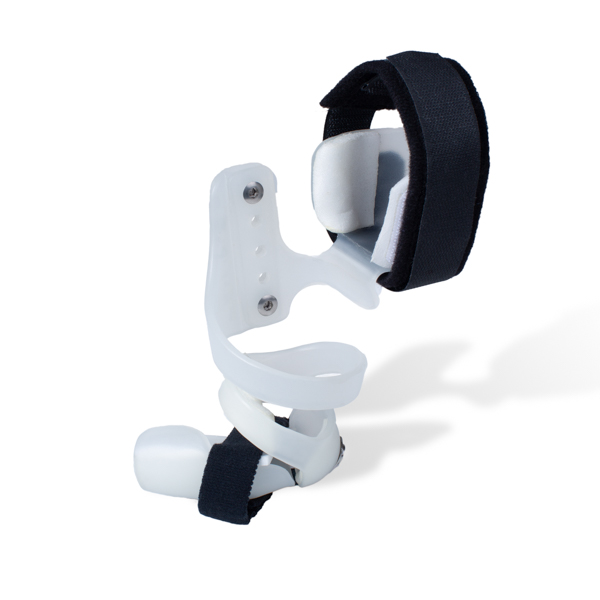The Cunningham Brace is the brainchild of Jerald Cunningham who runs his own clinic in Maine, USA. Jerald graduated cum laude from Cornell University with a degree in Physics and Cognitive studies. He is a guest lecturer at the University of New England’s Ph.D. Physical Therapy programme.
Jerald started developing the brace at the request of the orthopaedic surgeon he worked with. The consultant felt that whilst the Boots and Bar offered a successful treatment, they often caused a lot of distress to the child and parents. They can be difficult to put on, keep in place and children can find it difficult to sleep.
Jerald has worked on it for over a decade, continuously making development changes based upon the evidence provided by the in-brace x-rays taken after every patient fitting.

The Cunningham Brace (also known as the Dynamic Torsional KAFO or DTKAFO) is a flexible brace that is only fitted to the affected leg and allows movement for all of the normal activities such as crawling, rolling, standing and even walking.
The brace is always gently stretching the baby into the correct position so it is acting as though the therapist is always there manipulating and correcting the foot. In the case of a unilateral (single) club foot, because each leg is treated separately only the affected foot is involved (with the boots and bar approach, both feet have to be attached to the bar regardless.)
The end result is a very effective treatment protocol that has reduced treatment times to about a third of other treatments, and which typically requires only two braces during the two years that it is worn.
After a brief period, the baby is not even aware of the presence of the brace. This really improves comfort and compliance (and decreases stress for parents).
The big difference is that the Cunningham Brace is flexible and only fitted to the affected leg. This allows for the sort of dynamic movement you’d expect in babies, such as crawling, rolling and standing. Greater activity helps build a more developed muscular system – particularly calf muscles. Anecdotally we’ve seen a lot more symmetry in calf muscles using the Cunningham Brace than boots and bar. And because it’s a different kind of mechanism we don’t have to strap the feet up so tightly, which reduces issues such as blistering on the legs.
The Cunningham Brace is made from a series of measurements that we can either take in the clinic or help you to take during a virtual appointment. We hold a range of Cunningham braces in stock that we can adapt to the correct size and foot type of your baby. This process normally takes a few hours unless your child has a size that is out of the normal range or we do not have it in stock.
It depends on your child and the complexity of their case. On average, though, we’ll be looking to review your baby’s progress once a month over the course of treatment.
Treatment lasts about two years – this is around one-third of the time other methods require. In the first year, your baby will wear the brace for 23 hours a day – compared with boots and bar which can only be done for three months. This means we can help correct your baby’s foot while their tissue and bones are at their softest and most compliant. Once your baby is standing, they will only wear the brace during nighttime and naps.
The exact number will depend on your child and their condition, but typically a child will only need to wear two to three braces over a two-year period. The first for about six months, then a year each for the second and third.
Very often parents contact us before their baby is even born, having discovered the club foot on a scan. However, they first need to go through the Ponseti method with their consultant and then be triaged by a specialist physiotherapist before we can start treatment.

“It’s life-changing, my swimming coach has even remarked what a difference my treatment has made" Read how pectus bracing treatment helped to correct Aris' complex chest deformity, involving a combination of pectus excavatum, pectus carinatum and rib flaring.

Cerebral palsy patient Lucas sees significant improvement in his walking after only six months in his new custom Ankle Foot Orthoses (AFOs), designed by Professor Saeed Forghany in our Manchester clinic. Hear how a detailed gait analysis and bespoke AFOs significantly improved Lucas's gait and comfort.

Freddie’s positional plagiocephaly was treated successfully with the LOCBand Lite, going from 11mm to 2mm after four months in his helmet.

Adult club foot (talipes) patient Natasha says, "I cannot stress how amazing my AFOs are and how they have changed so much for me. The support they give me allows me to walk without crutches outside the house for the first time in over fifteen years."

Diagnosed with adolescent idiopathic scoliosis at 14 years old, Polly and mum Zoe looked to the LOC Scoliosis Brace to help her curve and avoid surgery at a later date.

LOC opens its first clinic in Northern Ireland, LOC Belfast, offer non-surgical orthotic treatment for scoliosis, pectus carinatum and pectus excavatum. Here, we will also be able to provide orthotic treatments for a range of adult and paediatric lower limb conditions including cerebral palsy, spina bifida, hypermobility, stroke, post-polio syndrome, and multiple sclerosis.

Mum Natalie shares her experience of having both her identical twins diagnosed with craniosynostosis. Ella and Nina had surgery at Great Ormond Street Hospital before going through cranial remoulding therapy at the London Orthotic Consultancy.

See how a thorough gait analysis and a correctly-fitted, bespoke Reciprocating Gait Orthosis (RGO) helped Ted, a spinal surgery and cancer survivor, improve his rehabilitation and mobility goals, getting him back on his feet again.